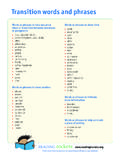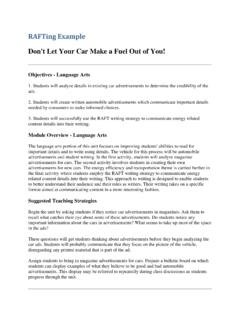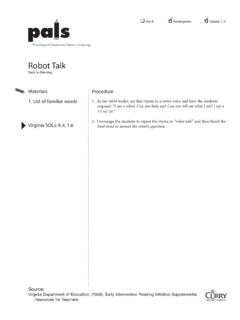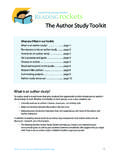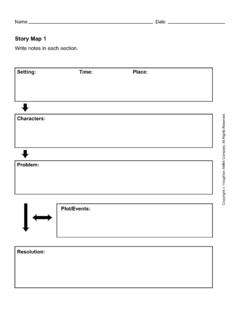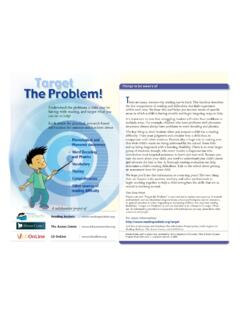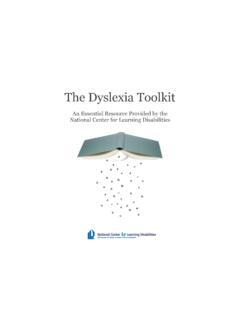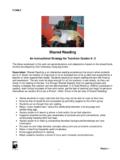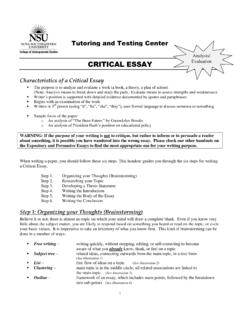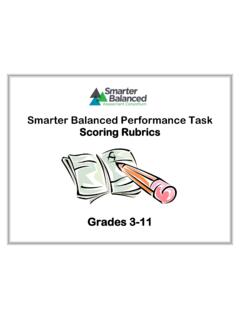Transcription of Quick Summarizing Strategies to Use in the Classroom
1 Quick Summarizing Strategies to Use in the Classroom Compiled by Ann Lewis, Laurel School District; and Aleta Thompson, Cape Henlopen School District; April 2010 1 Written Summaries Brief Description of the Strategy 3-2-1 List: 3 main points (or 3 somethings ), 2 controversial ideas (or two things I disagree with), and 1 question related to the key concept or learning Ticket Out The Door/Exit Ticket This can be the answer to any question about the day s work that you pose One clever way to pose the question is to ask them to answer So What? Other generic questions could be What do I want to remember?
2 , What was I supposed to learn from this lesson/reading/topic?, How could I communicate what I ve learned to someone else?, etc. The Important Thing Three important ideas/things from the lesson today are ---, ---, and ---, but the most important thing I learned today is ---. Questions to the Teacher List 3 (or any number) of questions you would still like clarified Squares, Triangles, Circles List 4 things that square with my thinking ; 3 angles I disagree with (or 3 details to support --, or 3 things for which I need more information, 3 different ways to look at the idea, etc.); and 1 question circling in my head Acrostics Give students a key word/concept from the lesson.
3 They must then write a detail or descriptor that starts with each of the letters of the key word/concept Carousel Brainstorming On chart paper around the room (or on paper that is passed around groups), ask small groups of students (3-4) to respond to a question or statement posed at the top of the paper. After a short period of time, student groups move on to another piece of chart paper/topic, and read what has been written about that topic and add to or respond to it. Key reminder: Ahead of time prepare the chart paper and the different topics, insuring that you have enough stations so that every group is at one station during each rotation.
4 These charts and responses can be used as a lesson activator or review the next day. $2 Summaries With each word worth 10 cents, write a $2 summary of the learning from the lesson. This can be scaffolded by giving students specific words related to the learning that they must include in their summaries. This can be increased to any amount of money. Gist Students are given a grid of blanks (any number, depending on the age/level of the student and the level of complexity of the topic). They must fill each blank with a word or phrase helps capture the gist of the learning. Headline Summaries Similar to $2 summaries, have students write a newspaper headline that gives the main points of the lesson.
5 Journals If students keep journals for the course, have the Summarizing activity be an entry in the journal. You might include a prompt to get them started. RAFT A writing situation where students choose Role (from whose point of view), Audience (the specific reader to whom the piece is being written), Form or Format (a letter, memo, list, email, etc.), Topic (specific subject of the writing ) K-W-L If you started the lesson with a K-W-L (what I Know, what I Want to know, what I Learned), then complete the L(learned) section as the summary. Revisit Anticipation Guide Ask students to go back to the anticipation guide from the beginning of the lesson and revise their answers.
6 You can also ask them to justify the changes. Vanity Tag/Bumper Sticker Write a vanity tag for a car or a bumper sticker that describes the key ideas from the lesson. Think-Pair-Write Similar to Think-Pair-Share, students are given a topic/question, they brainstorm it with a partner, but then each student writes his/her own response. Think-Write-Share Similar to above but the sharing is oral. Students think about a question, write a response, then share with their partners. Word Splash Students are given a splash of the key words from the lesson. They must write a few meaningful sentences (summarize the learning) using these words.
7 Key Points Summary Students make a list of bulleted key points of the learning from the lesson. Quick Summarizing Strategies to Use in the Classroom Compiled by Ann Lewis, Laurel School District; and Aleta Thompson, Cape Henlopen School District; April 2010 2 Written Conversations Each student begins the answer to a question or prompt posed by the teacher. Then after 1 or 2 minutes of writing , they exchange their papers (or pass them around). Then they spend 1-2 minutes responding to the writing /thinking on the paper they receive. Then they pass the paper the paper back (or on) and continue the process.
8 Limit the time, using a timer or other signal, so that students are always left thinking they have more to say. SQ3R Survey, Question, Read, Recite, Review. While this is a teaching/reading strategy, the last part of it could constitute a summary at the end of the reading/lesson. See: Changing Points of View Ask students to do a Quick -write about a topic related to the learning from lesson from a very specific point of view. ( , What would X say about --?) Sample Test Questions Ask students to write one or several possible test questions related to the learning of the lesson. These questions should not be yes/no or one-word answer questions.
9 An easy way to do this is to use index cards or half-pieces of paper, and ask the student to write the question on one side and an acceptable, detailed answer on the other. These questions can be collected and then redistributed the next day and used as a warm up or lesson activator. One-Sentence Summary Summarize in one sentence the key point of the lesson (be specific about what to summarize , the importance of ---) Paragraph Summary Instead of writing a sentence, students expand. You can ask them to describe at least 3 reasons or support or details Dear Student Letter Write a letter to an absent student telling him/her --- (the point of the lesson, the steps in a process, the details learned through the lesson, etc.)
10 A variation could be Dear Teacher or Dear Citizen/Voter, (depending on the purpose of the learning or the topic and the content area) Aha! and Huh? Write down 1 or 2 ahas (something you learned) and 1 or 2 huhs (things you still have questions about) 6-Word Memoirs In 6 words, what did you learn? (This is a variation of the Smith Magazine writing contest) For samples, see: or Framed Paragraph Do a paragraph skeleton or frame which students have to complete (for example: XX happened because of 3 important factors. The first is and it caused ---. The second is and it caused ---. Etc.) Sentence Starters Similar to framed paragraphs, start the sentence and have students finish it (for example: One thing I learned about X today is ---, or One important reason why --- is ---) Inference Frame Similar to a framed paragraph, this frame helps students draw inferences from what they ve been reading/viewing/discussing by connecting that new information to their background knowledge to make inferences.

